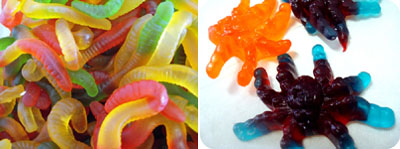 |
Ambiences and Tendencies
How Children Are Unconsciously
Being Deformed…
Marian T. Horvat
The well-known JellyBelly’s has sunk to a new low with one of their novelty candies: the new “wild” and “fun” boxes of BeanBoozled jelly beans.

The back of the package presents the good/bad flavors |
Each package contains pairs of identical-looking Jelly Beans – except for that one is tasty and the other is revolting. For example, the peach colored bean can actually taste like Peach – or like Vomit. The green bean might be Juicy Pear – or Booger. You may think you’re getting the Buttered Popcorn bean, but find yourself tasting Rotten Egg. There is a Café Latte that pairs with Ear Wax, a Licorice and Skunk Spray, a Coconut and Baby Wipes, and so on. Both the good and the bad “flavors,” according to various reviews, are perfectly captured.
Then the supposed “fun” begins, you read in the advertisements. You invite someone to eat the bean to see if he gets the tasty or disgusting one. No, there is no way to tell by smelling – you have to actually bite into it. It's “loads of fun,” we are told, to impose the disgusting things onto an unsuspecting taster. If he gets a vomit or ear wax bean, he is BeanBoozled, a play on the word bamboozled, or hoodwinked. It’s “a load of laughs.”
Even more revolting than the flavors, in my view, is the notion of offering candy to children and friends to have a laugh at their expense. Today, everything is geared toward the joke and having fun, to the point where we have jelly beans that taste like ‘boogers’ and skunk spray. If we object, we are told to “lighten up” – it’s just good fun…
Unseen tendencies in the process
Several readers have asked me to explain more about the Tendential Revolution and how to discern and fight it in our everyday lives. I think this revolting candy provides an excellent opportunity to explain it further, and show the importance of rejecting this type of foolishness.
First, whether you like the BeanBoozled jelly beans is more than a matter of taste. The whole idea of transforming something that is abject and horrible into a suitable treat for children is what we would call tendentially wrong. That is, it moves the tendencies of a person in the wrong direction.
In this case, it induces the child to imagine what is repulsive and disgusting should be considered normal and even entertaining. In the name of “having fun,” what actually happens is that one accustoms children to the perspective of eating ear wax, vomit, baby wipes etc. The psychological boundaries of propriety and decorum are broken and a tolerance for the heinous is introduced.

Worms and spiders - treats for children |
We can apply this conclusion – which is crystal clear in this extreme case – to other novelty candies, such as the gummy worms or candy tarantula spiders. I am not addressing the question of whether eating such candies or allowing one’s children to do so is a sin. What I am stressing is that this practice moves their tendencies in a wrong direction by helping to dissolve the clear line that should exist between what is good and bad, beautiful and horrible, delightful and repulsive.
Instinctively a child is repelled by a slimy worm or afraid of a large black spider. The candy worms and spiders are destructive: They encourage a child to ignore his good instincts, to consider what is naturally repulsive and fearful as something delicious or funny.
It is a small – but not insignificant step – the Revolution wants to take to deform the criteria of the child and his innocence. His normal, sound tendency is to see what is good, true and beautiful as a reflection of God; at the same time, he should view what is ugly, bad and false as a reflection of the Devil or original sin.
Should we tend toward excellence or abjection?
An interesting way to realize how the Revolution subverts all the good customs and tendencies that were born in our glorious Catholic past is by contrast. In the past, candy was something that was a delight for the palate and the eye. Confectionery artists and chocolatiers crafted delicious pieces that were attractive and, in some cases, veritable works of arts. The candy-making industry was generally turned toward excellence, appealing to the more elevated tendencies of society.

Candies turned toward excellence are still available in the U.S. |
Each country and region would develop its own special bonbon or a distinctive way of making a special candy. The German marzipan, for example, is made by grinding whole almonds with sugar and partially drying the paste, and French marzipan is made by combining ground almonds with sugar syrup. In Italy, it is often shaped and painted with food colorings to resemble fruit – frutta martorana. In Toledo the marzipan is shaped into simple animal shapes and filled in with egg yolk (yema) and sugar.
This diversity and variety of recipes and presentations in one simple candy – always presented with charm and beauty – expresses in its small way a rich fruit of our past Christian Civilization, which strove for excellence in every sphere of life, grand or small.
The revolutionary jelly beans represent the exact opposite, a level of decadence that should be rejected by the Catholic and counter-revolutionary soul. Instead of striving to achieve new levels of distinction and taste to educate our palate to greater refinement, candy makers are actually studying how to make “authentic” nauseating flavors. Then children and those who love sweets are being invited to become acquainted with the monstrous – a monstrous presented as hilariously fun.

Posted April 12, 2010

Related Topics of Interest
 The Principle of Gradualism The Principle of Gradualism
 Revolution in the Tendencies Revolution in the Tendencies
 Nourishing an Appetite for the Marvelous Nourishing an Appetite for the Marvelous
 Please Say Children, Not Kids Please Say Children, Not Kids
 Era of the Child Era of the Child
 Satanism in the Man's Domain Satanism in the Man's Domain
 The Role of Authority in the Family The Role of Authority in the Family
 Secret Spells Barbie & the Tendencial Revolution Secret Spells Barbie & the Tendencial Revolution
 The Subtle Invasion of Satanism The Subtle Invasion of Satanism

Related Works of Interest
|
|
Ambiences | Cultural | Home | Books | CDs | Search | Contact Us | Donate

© 2002- Tradition in Action, Inc. All Rights Reserved
|
 |

|